NOTES
ABOUT THIS PUBLICATION
This publication presents national statistics on prisoners who were in custody on 30 June 2006. These statistics describe the characteristics of prisoners, sentence lengths, and offences for which offenders are imprisoned, and provide a basis for measuring change over time.
FURTHER INFORMATION
More information about ABS activities in the field of crime and justice statistics is available from the Crime and Justice theme page on the ABS website <www.abs.gov.au>. Details of other ABS publications relating to Crime and Justice statistics can be found in paragraphs 80-81 of the Explanatory Notes.
ACKNOWLEDGEMENTS
The ABS acknowledges the valuable contribution of the Board of Management and Advisory Group of the National Corrective Services Statistics Unit and the staff of the various agencies that provide the statistics that are presented in this publication.
INQUIRIES
For further information about these and related statistics, contact the National Information and Referral Service on 1300 135 070 or Marika Woodberry on Melbourne (03) 9615 7601.
SUMMARY COMMENTARY
INTRODUCTION
This publication presents information from the National Prisoner Census about persons held in Australian prisons on the night of 30 June 2006. The National Prisoner Census covers all prisoners in the legal custody of adult corrective services in adult prisons, including periodic detainees in New South Wales and the Australian Capital Territory, but excluding persons held in juvenile institutions, psychiatric custody and police custody. It is based on data extracted from administrative records held by the corrective services agencies in each Australian state and territory. These statistics provide a profile of the legal status and sentence details as well as demographic characteristics of Australian prisoners.
Users of this publication should note that it provides a picture of the persons in prison at a point in time (30 June 2006), and does not represent the flow of prisoners during the year. The majority of prisoners in the annual Prisoner Census were serving long-term sentences for serious offences, whereas the flow of offenders in and out of prisons consists primarily of persons serving short sentences for lesser offences. Complementary information to this publication about Australian prisoners is available in the Australian Bureau of Statistics (ABS) quarterly publication, Corrective Services, Australia (cat.no. 4512.0).
The Explanatory Notes provide detailed information on the data sources, definitions, counting rules and other technical matters associated with this publication.
For ease of reading, 'most serious offence/charge' is referred to as 'offence/charge' throughout this publication. The term 'related offences' has also been omitted for ease of reading for the following offences/charges: homicide and related offences; sexual assault and related offences; robbery, extortion and related offences; theft and related offences; and deception and related offences.
PRISONER SNAPSHOT
At 30 June 2006 there were 25,790 prisoners (sentenced and unsentenced) in Australian prisons, an increase of 2% (437 prisoners) from 30 June 2005. This represented an imprisonment rate of 163 prisoners per 100,000 adult population.
Unsentenced prisoners comprised 22% (5,581) of the total prisoner population, an increase of 9% (448 prisoners) since 30 June 2005. Most (57% or 14,676) prisoners had served a sentence in an adult prison prior to the current episode. The offence/charge of acts intended to cause injury accounted for the highest proportion (18% or 4,630) of all prisoners.
Of the total prisoner population, 7% (1,827) were female and 24% (6,091) were Indigenous. The median age of all prisoners was 33 years.
Three quarters of the total prisoner population was located in New South Wales (38% or 9,822), Queensland (22% or 5,562) and Victoria (15% or 3,905).
Changes in the prisoner population
The total prisoner population increased by 2% from 25,353 on 30 June 2005 to 25,790 on 30 June 2006. Over the ten year period, from 1996, the prisoner population increased by 42%.
CHANGE IN PRISONER NUMBERS BETWEEN 30 JUNE 2005 AND 30 JUNE 2006
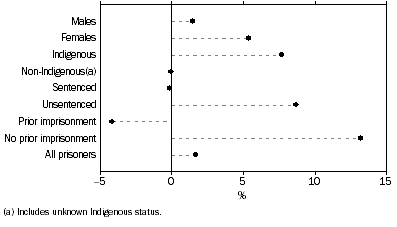
Between 2005 and 2006, the prisoner population increased in all states and territories except for the Australian Capital Territory, Tasmania and the Northern Territory. The decrease in the Australian Capital Territory is due to a change in the way the Australian Capital Territory counts periodic detainees (see Explanatory Notes, paragraph 77). Tasmania decreased by 7% and the Northern Territory by 3%. The highest proportional increases were for South Australia and Victoria (both 6%) followed by Queensland (4%).
CHANGE IN PRISONER NUMBERS BETWEEN 30 JUNE 2005 AND 30 JUNE 2006, states and territories
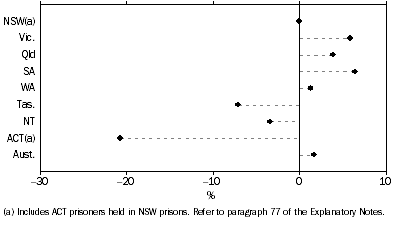
Imprisonment rates
At 30 June 2006, the Australian imprisonment rate was 163 prisoners per 100,000 adult population, representing a marginal increase of less than 1% since 30 June 2005. Most states and territories recorded a decrease in imprisonment rates between 2005 and 2006. The largest imprisonment rate decreases were in the Australian Capital Territory (22%), Tasmania (8%) and the Northern Territory (6%). Victoria, South Australia and Queensland recorded increases in imprisonment rates (6%, 5% and 1% respectively).
IMPRISONMENT RATES(a)
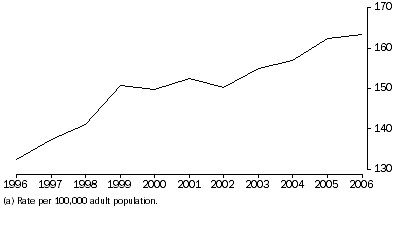
Indigenous prisoners
Indigenous prisoners represented 24% of the total prisoner population at 30 June 2006, the highest proportion at 30 June since 1996.
Caution should be exercised when interpreting increases in Indigenous prisoners as increases may have been impacted by changes to the collection and recording of Indigenous information, or the willingness of Indigenous persons to self-identify.
The proportion of prisoners that were Indigenous was variable across states and territories. In the Northern Territory 82% of the prisoner population was Indigenous while Victoria had the lowest proportion (6%).
When comparing rates of imprisonment for Indigenous and non-Indigenous prisoners, it is recommended that age standardised rates be used. (For further explanation refer to Explanatory Notes, paragraphs 24-29.) The age standardised rate of Indigenous imprisonment was 1,668 per 100,000 adult Indigenous population, 13 times more than the non-Indigenous rate at 30 June 2006.
Indigenous persons were 18 times more likely to be in prison than non-Indigenous persons in Western Australia. In Tasmania, Indigenous persons were 3 times more likely to be in prison, recording the lowest age standardised ratio of Indigenous to non-Indigenous rates of imprisonment.
RATIO OF INDIGENOUS TO NON-INDIGENOUS AGE STANDARDISED RATES OF IMPRISONMENT(a)
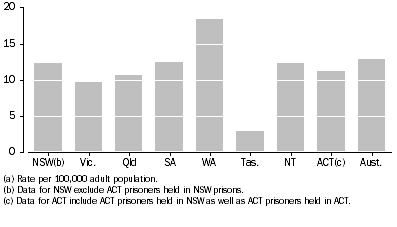
MOST SERIOUS OFFENCE/CHARGE
A most serious offence/charge is determined for each prisoner (see paragraphs 61-63 of the Explanatory Notes). At 30 June 2006, the most prevalent offences/charges for prisoners (either sentenced or unsentenced) were: acts intended to cause injury (18%); unlawful entry with intent (12%); sexual assault (11%); robbery and extortion (10%); homicide (10%); and illicit drug offences (10%).
Similar proportions of males and females were in prison for an offence/charge of homicide (10% of males, 11% of females) and acts intended to cause injury (18% of males, 17% of females). Other offences varied between males and females, with a higher proportion of males in prison for sexual assault than females (12% of males, 1% of females), and robbery and extortion (10% of males, 7% of females). There was a higher proportion of females than males in prison for deception (9% of females, 3% of males), theft (11% of females, 5% of males), and illicit drug offences (14% of females, 10% of males).
SELECTED MOST SERIOUS OFFENCE/CHARGE, by sex
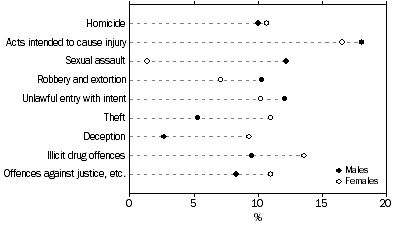
AGE AND SEX
Males dominated the prisoner population comprising 93% (23,963) of the total, whilst females comprised 7% (1,827). The number of female prisoners increased by 5% (93) from 30 June 2005, whilst the number of male prisoners increased by 1% (344) for this same period. Over the last 10 years the number of female prisoners has increased by 90% from 964 at 30 June 1996 to 1,827 at 30 June 2006. The number of male prisoners has increased by 39% from 17,229 to 23,963 for the same period.
CHANGE IN PRISONER NUMBERS BETWEEN 30 JUNE 1996 AND 30 JUNE 2006
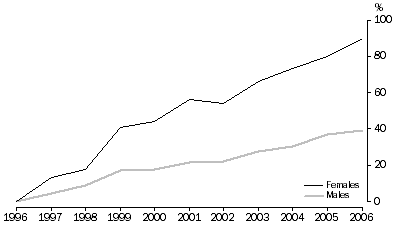
The imprisonment rate for males was 308 prisoners per 100,000 adult male population, 13 times more than for females (23 prisoners per 100,000 adult female population).
New South Wales had the highest proportion of female prisoners (8% or 740 female prisoners), whilst the lowest proportion was in the Northern Territory (4% or 35 female prisoners).
PROPORTION OF FEMALE PRISONERS, states and territories
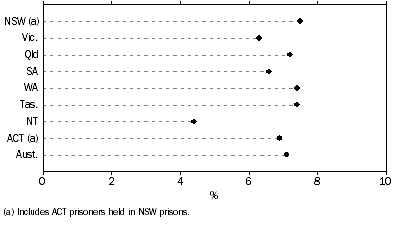
The median age of all prisoners in Australian prisons at 30 June 2006 was 33 years. Most prisoners (70%) were aged between 20 and 39. Prisoners aged less than 20 comprised 3% of the total prisoner population.
Prisoners with an offence/charge of sexual assault had the highest median age (42 years), while robbery and extortion had the lowest (29 years).
Indigenous prisoners
The age profile of Indigenous prisoners differed to non-Indigenous prisoners. The median age of Indigenous prisoners was 31 while non-Indigenous prisoners was 34. There were proportionally more Indigenous prisoners (83%) aged under 40, than non-Indigenous prisoners (70%).
PRIOR IMPRISONMENT
Caution should be exercised in interpreting prior imprisonment data as National data is impacted by the under enumeration of Queensland data (see Explanatory Notes paragraph 71).
The majority (57%) of prisoners in custody at 30 June 2006 had served a sentence in an adult prison prior to the current episode.
PRIOR IMPRISONMENT(a), by selected most serious offence/charge
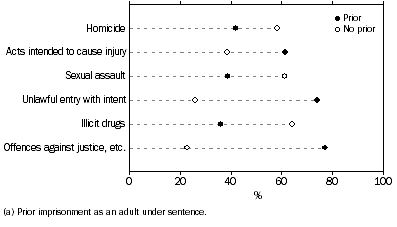
The offence/charge of offences against justice procedures, government security and operations had the highest proportion (77%) of prisoners with prior imprisonment, followed by unlawful entry with intent (74%). Illicit drug offences had the lowest (36%) proportion of prisoners with prior imprisonment.
The proportion of prisoners with prior imprisonment was over half of all prisoners, in all states and territories, ranging from 52% in South Australia to 68% in the Northern Territory.
SENTENCED PRISONERS
There were 20,209 sentenced prisoners in Australian prisons at 30 June 2006, a decrease of less than 1% since 30 June 2005 (20,220).
Most serious offence
Six offences accounted for 70% of sentenced prisoners: acts intended to cause injury (15%); sexual assault and unlawful entry with intent (both 12%); homicide, illicit drug offences, and robbery and extortion (all 10%).
Over the past 5 years, the proportion of sentenced prisoners with an offence of acts intended to cause injury increased from 12% in 2001 to 15% in 2006. The proportion of prisoners with an offence of robbery and extortion decreased over the same period from 14% in 2001 to 10% in 2006.
Most serious offence - Indigenous prisoners
Over 40% of all Indigenous prisoners were sentenced for acts intended to cause injury (28%) and unlawful entry with intent (14%). In comparison, these offences accounted for just over 20% of all non-Indigenous sentenced prisoners, with acts intended to cause injury and unlawful entry with intent both at 11%. Indigenous sentenced prisoners with an offence of illicit drugs comprised 2% of the total number of sentenced Indigenous prisoners compared to 13% of non-Indigenous sentenced prisoners.
Prisoners sentenced in the last 12 months
Half (or 10,154) of all sentenced prisoners were sentenced in the 12 months preceding 30 June 2006. Of those prisoners sentenced in the last 12 months, 61% had served a sentence in an adult prison prior to the current episode being served.
Sentence lengths - aggregate sentence length
Of all sentenced prisoners, 5% were serving life or another indeterminate sentence, while a further 4% were serving a sentence of periodic detention (available in New South Wales and the Australian Capital Territory only). Of the remaining sentenced prisoners, the majority (63%) had an aggregate sentence length of less than 5 years. Those with an aggregate sentence length of less than 2 years comprised 35% of all sentenced prisoners.
Excluding prisoners with indeterminate, life and periodic detention sentences, the median aggregate sentence length for sentenced prisoners was 3 years (36 months). (See paragraphs 56-58 of the Explanatory Notes for information about interpreting mean and median sentence lengths based on a census 'snapshot'). The longest median aggregate sentence lengths were for homicide (15 years or 180.1 months), sexual assault (7 years or 84 months) and robbery and extortion (6 years or 72 months). The median aggregate sentence lengths for all three of these offences have remained unchanged since 30 June 2005.
Expected time to serve
Expected time to serve takes into account the earliest date of release for sentenced prisoners. The median expected time to serve for sentenced prisoners at 30 June 2006 was 1.9 years (22.4 months). The majority (78%) of prisoners had an expected time to serve of less than 5 years, while 63% of sentenced prisoners had an aggregate sentence of less than 5 years. (These figures exclude prisoners with life without a minimum, indeterminate, and periodic detention sentences).
SENTENCED PRISONERS, by median sentence length and selected most serious offence(a)
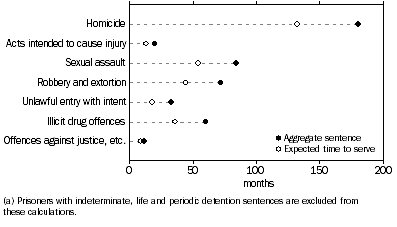
UNSENTENCED PRISONERS
Unsentenced (remand) prisoners include unconvicted prisoners awaiting a court hearing or trial, convicted prisoners awaiting sentencing and persons awaiting deportation. The proportion of unsentenced prisoners to the total prisoner population in Australian prisons on 30 June 2006 was 22%, an increase of 2% since 30 June 2005. There were a total of 5,581 unsentenced prisoners, an increase of 9% since 30 June 2005 (5,133). Half of these unsentenced prisoners had served a prior term of imprisonment.
All states and territories reported an increase in the number of unsentenced prisoners except for Tasmania (a decrease of 4 prisoners), and the Australian Capital Territory (a decrease of 19 prisoners). Of all states and territories, South Australia had the highest proportion (35%) of unsentenced prisoners. Western Australia had the lowest proportion of unsentenced prisoners (17%).
Most serious charge
Of the unsentenced prisoners, 29% had a most serious charge of acts intended to cause injury, followed by unlawful entry with intent (12%).
Caution should be exercised when comparing most serious charge between 2006 and previous years, as movements have been impacted by a change to the classification used to determine most serious charge for some states and territories (see Explanatory Notes paragraph 63).
Time on remand
Time on remand is influenced by a number of factors, including the time it takes for a case to come before a court, and eligibility for and availability of bail. The median number of months spent on remand by unsentenced prisoners in custody at 30 June 2006 was 2.6 months. (See paragraphs 56-58 of the Explanatory Notes for information about interpreting median time on remand based on a census 'snapshot'). The longest amount of time spent on remand was by prisoners charged with homicide (median of 8.8 months), followed by sexual assault (median of 4.5 months).
Indigenous unsentenced prisoners
Indigenous unsentenced prisoners were more likely to be on remand for acts intended to cause injury (45%) than non-Indigenous unsentenced prisoners (24%). Indigenous unsentenced prisoners were less likely to be on remand for charges of homicide and related offences (7% of Indigenous remandees, 10% of non-Indigenous remandees) and illicit drug offences (1% of Indigenous remandees, 10% non-Indigenous remandees).
The median time spent on remand by Indigenous prisoners at 30 June 2006 was 2.1 months, less than that spent on remand by non-Indigenous prisoners (2.9 months). The median time on remand by Indigenous prisoners was less than non-Indigenous prisoners for almost all charge types except sexual assault (5.6 months for Indigenous prisoners compared to 4.4 months for non-Indigenous prisoners), unlawful entry with intent (2.2 months compared to 2.0 months respectively) and public order offences (1.9 months compared to 1.7 months respectively).
PERIODIC DETAINEES
The sentencing option of periodic detention, where detainees are in custody for two consecutive days in a week and remain at liberty the rest of the week, is available only in New South Wales and the Australian Capital Territory. There were 777 periodic detainees at 30 June 2006. The number of periodic detainees decreased since 2005 both in New South Wales and the Australian Capital Territory, however the decrease in the Australian Capital Territory is due to a change in the way the Australian Territory counts periodic detainees (see Explanatory Notes, paragraph 77). In New South Wales the number of periodic detainees decreased by 15% (from 855 in 2005 to 724 in 2006).
 Print Page
Print Page
 Print All
Print All